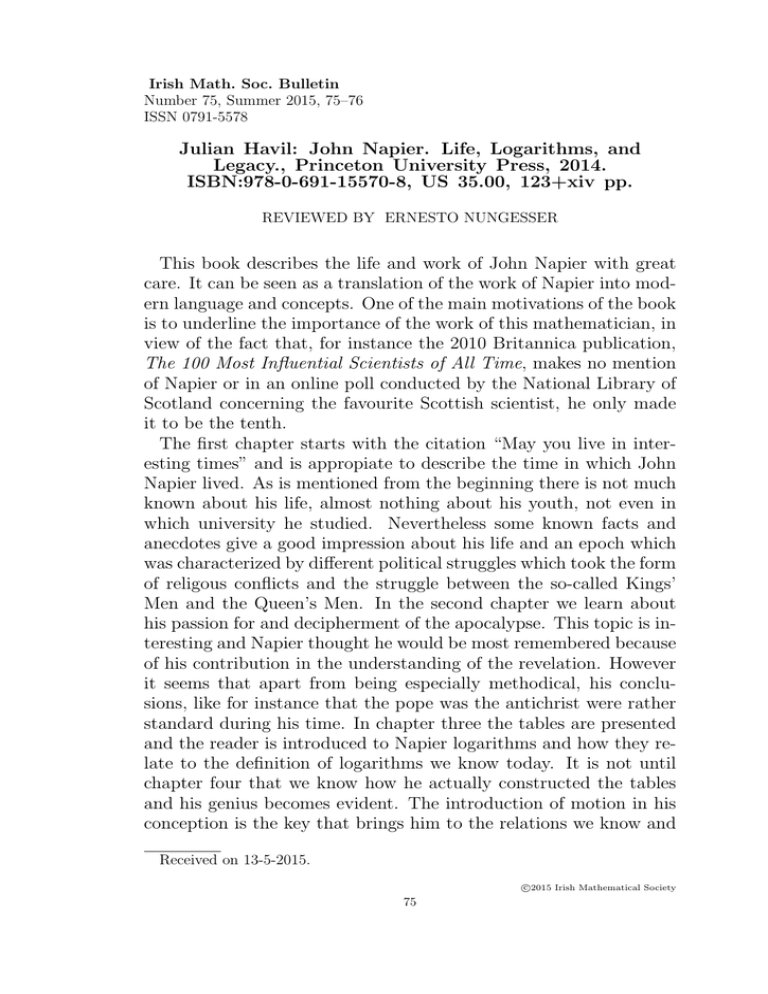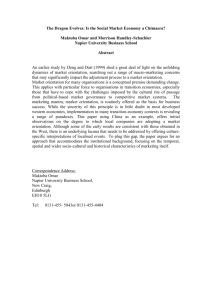Julian Havil: John Napier. Life, Logarithms, and
advertisement

Irish Math. Soc. Bulletin Number 75, Summer 2015, 75–76 ISSN 0791-5578 Julian Havil: John Napier. Life, Logarithms, and Legacy., Princeton University Press, 2014. ISBN:978-0-691-15570-8, US 35.00, 123+xiv pp. REVIEWED BY ERNESTO NUNGESSER This book describes the life and work of John Napier with great care. It can be seen as a translation of the work of Napier into modern language and concepts. One of the main motivations of the book is to underline the importance of the work of this mathematician, in view of the fact that, for instance the 2010 Britannica publication, The 100 Most Influential Scientists of All Time, makes no mention of Napier or in an online poll conducted by the National Library of Scotland concerning the favourite Scottish scientist, he only made it to be the tenth. The first chapter starts with the citation “May you live in interesting times” and is appropiate to describe the time in which John Napier lived. As is mentioned from the beginning there is not much known about his life, almost nothing about his youth, not even in which university he studied. Nevertheless some known facts and anecdotes give a good impression about his life and an epoch which was characterized by different political struggles which took the form of religous conflicts and the struggle between the so-called Kings’ Men and the Queen’s Men. In the second chapter we learn about his passion for and decipherment of the apocalypse. This topic is interesting and Napier thought he would be most remembered because of his contribution in the understanding of the revelation. However it seems that apart from being especially methodical, his conclusions, like for instance that the pope was the antichrist were rather standard during his time. In chapter three the tables are presented and the reader is introduced to Napier logarithms and how they relate to the definition of logarithms we know today. It is not until chapter four that we know how he actually constructed the tables and his genius becomes evident. The introduction of motion in his conception is the key that brings him to the relations we know and Received on 13-5-2015. c 2015 Irish Mathematical Society 75 76 ERNESTO NUNGESSER love. In the remaining three chapters his work is put into context with modern computation and his legacy. That a new technology had been born is evident. As is described in the book in the beginning Napier was dealing with sines, until he later realized that his construction was not that artificial and really helped to treat relations in general. Logarithms are central in the conception of bases of numbers and is closely related to the decimal system. This is explained in detail in the last three chapters together with Napier’s bones. Alltogether it seems difficult to put the work of this man into context with other mathematicians. What seems marvellous is the combination of mystical and practical thinking in his work. The year 2012 was the 400th anniversary of Napier’s publication Descriptio and in view of the fact that the younger generations will not even know of the existence of the logarithmic tables, there is a good reason to write about the work of this man. It is clearly a very interesting book from a historical perspective. Ernesto Nungesser is a postdoctoral researcher at Trinity College Dublin, currently funded by the Irish Research Council. His main research interests are related to relativistic kinetic theory. School of Mathematics, Trinity College Dublin E-mail address: ernesto@maths.tcd.ie










